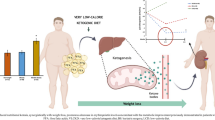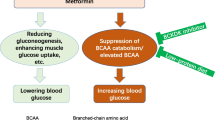Abstract
This study investigated the anti-diabetic preventive activity of coenzyme Q10 (CoQ10) in a murine model of diet-induced insulin resistance (IR), Psammomys obesus (Po). IR was induced by feeding a standard laboratory diet (SD). CoQ10 oil suspension was orally administered at 10 mg/kg body weight (BW)/day along with SD for 9 months. Anthropometric parameters, namely, total body weight gain (BWG) and the relative weight of white adipose tissue (WAT) were determined. Blood glucose, insulin, quantitative insulin sensitivity check index (QUICKI), total antioxidant status (TAS), iron, malondialdehyde (MDA) and nitrite (NO2 −) were evaluated. NO2 − level was also assessed in peripheral blood mononuclear cells (PBMCs) culture supernatants. Our results show that CoQ10 supplementation significantly improved blood glucose, insulin, QUICKI, TAS, iron and MDA, but influenced neither NO2 − levels nor the anthropometric parameters. These findings support the hypothesis that CoQ10 would exert an anti-diabetic activity by improving both glycaemic control and antioxidant protection. The most marked effect of CoQ10 observed in this study concerns the regulation of iron levels, which may carry significant preventive importance.

Similar content being viewed by others
References
Zoltowska M, Ziv E, Delvin E, Sinnett D, Kalman R, Garofalo C, Seidman E, Levy E (2003) Cellular aspects of intestinal lipoprotein assembly in Psammomys obesus a model of insulin resistance and type 2 diabetes. Diabetes 52:2539–2545
Pitocco D, Zaccardi F, Di Stasio E, Romitelli F, Santini SA, Zuppi C, Ghirlanda G (2010) Oxidative stress, nitric oxide, and diabetes. Rev Diabet Stud 7(1):15–25
Chew GT, Watts GF (2004) Coenzyme Q10 and diabetic endotheliopathy: oxidative stress and the ‘recoupling hypothesis’. Q J Med 97:537–548
Bloch-Damti A, Bashan N (2005) Proposed mechanisms for the induction of insulin resistance by oxidative stress. Antioxid Redox Signal 7:1553–1567
Bank G, Kagan D, Madhavi D (2011) Coenzyme Q 10: clinical update and bioavailability. J Evidence-Based Complementary Altern Med 16(2):129–137
Greenberg S, Frishman WH (1990) Co-enzyme Q10: a new drug for cardiovascular disease. J Clin Pharmacol 30:596–608
Rauchova H, Drahota Z, Lenaz G (1995) Function of coenzyme Q in the cell: some biochemical and physiological properties. Physiol Res 44:209–216
Mohr D, Umeda Y, Redgrave TG, Stocker R (1999) Antioxidant defenses in rat intestine and mesenteric lymph. Redox Rep 4:79–87
Directive 2010/63/EU of the European Parliament and of the Council of 22/07/2010 on the protection of animals used for scientific purposes. Official Journal of the EU 20.10.2010:L276/33–79
Katz A, Nambi SS, Mather K, Baron AD, Follmann DA, Sullivan G, Quon MJ (2000) Quantitative insulin-sensitivity check index: a simple, accurate method for assessing insulin sensitivity in humans. J Clin Endocrinol Metab 85:2402–2410
Walder K, Oakes N, Fahey RP, Cooney G, Zimmet PZ, Collier GR (2002) Profile of dyslipidemia in Psammomys obesus, an animal model of the metabolic syndrome. Endocr Regul 36:1–8
Ohkawa H, Ohishi N, Yagi K (1979) Assay for lipid peroxides in animal tissues by thiobarbituric acid reaction. Anal Biochem 95:351–358
Touil-Boukoffa C, Bauvois B, Sanceau J, Hamrioui B, Wietzerbin J (1998) Production of nitric oxide (NO) in human hydatidosis, relationship between nitrite and IFN-gamma levels. Biochimie 80:739–744
Modi K, Santani DD, Goyal RK, Bhatt PA (2006) Effect of coenzyme Q10 on catalase activity and other antioxidant parameters in streptozotocin-induced diabetic rats. Biol Trace Elem Res 109:25–32
Mebarki-Atek F, Bouderba S, Belarbi C, Zelmat A, Raache R, Griene L, Favier R, Leverve X, Koceir EA (2009) Impact of thyroidal hormones on insulin resistance in the pathogenesis of diabetes, preventive effect of reverse T3 (3, 3′, 5′- triido-L-thyronine) in Psammomys obesus, an experimental model of type 2 diabetes. Médecine du Maghreb 165:21–25
Aouichat-Bouguerra S, Bourdillon MC, Dahmani Y, Bekkhoucha F (2001) Non insulin dependent diabetes in sand rat (Psammomys obesus) and production of collagen in cultured aortic smooth muscle cells, influence of insulin. Int J Exp Diabetes Res 2:37–46
Hodgson JM, Watts GF, Playford DA, Burke V, Croft KD (2002) Coenzyme Q (10) improves blood pressure and glycaemic control: a controlled trial in subjects with type 2 diabetes. Eur J Clin Nutr 56:1137–1142
Singh RB, Niaz MA, Rastogi SS, Shukla PK, Thaku AS (1999) Effect of hydrosoluble CoQ10 on blood pressure and insulin resistance in hypertensive patients with coronary artery disease. J Hum Hypertens 13:203–208
Taylor AA (2001) Pathophysiology of hypertension and endothelial dysfunction in patients with diabetes mellitus. Endocrinol Metab Clin N Am 30:983–997
Nakamura T, Sanma H, Himeno M, Kato K (1980) Effects of exogenous ubiquinone-10 on endogenous ubiquinone-10 in canine plasma and on electron transport enzymes. In: Yamamura Y, Folkers K, Ito Y (eds) Biomedical and clinical aspects of coenzyme Q 10, vol 2. Elsevier/North-Holland Biomedical Press, Amsterdam, pp. 3–14
Pepping J (1999) Coenzyme Q10. Am J Health-Syst Pharm 56:519–521
Brownlee M (2005) The pathobiology of diabetic complications: a unifying mechanism. Diabetes 54:1615–1625
Friedman J, Peleg E, Kagan T, Shnizer S, Rosenthal T (2003) Oxidative stress in hypertensive, diabetic and diabetic hypertensive rats. Am J Hypertens 16:1049–1052
Witting PK, Pettersson K, Letters J, Stocker R (2000) Anti-atherogenic effect of coenzyme Q10 in apolipoptrotetin E gene knockout mice. Free Radic Biol Med 29:295–305
Lee BJ, Huang YC, Chen SJ, Lin PT (2011) Coenzyme Q10 supplementation reduces oxidative stress and increase antioxidant enzyme activity in patients with coronary artery disease. Nutrition. doi:10.1016/j.nut.2011.06.004
Maxel T, Pold R, Larsen A, Pedersen SB, Carlson D, Rolin B, Bödvarsdóttir TB, Lund S, Rungby J, Smidt K (2015) Dysregulation of zinc and iron balance in adipose tissue from diabetic sand rats (Psammomys obesus). J Diabetes Metab 6:497. doi:10.4172/2155-6156.1000497
Patt A, Horesh IR, Berger EM, Harken AH, Repine JE (1990) Iron depletion or chelation reduces ischemia/reperfusion-induced edema in gerbil brains. J Pediatr Surg 25(2):224–228
Fernández-Real JM, López-Bermejo A, Ricart W (2002) Cross-talk between iron metabolism and diabetes. Diabetes 51:2348–2354
Swaminathan S, Alam MG, Fonseca VA, Shah SV (2007) The role of iron in diabetes and its complications. Diabetes Care 30:1926–1933
Brudevold R, Hole T, Hammerstrøm J (2008) Hyperferritenemia is associated with insulin resistance and fatty liver in patients without iron overload. PLoS One 3:e3547
Green A, Basile R, Rumberger JM (2006) Transferrin and iron induce insulin resistance of glucose transport in adipocytes. Metabolism 55:1042–1045
Minamiyama Y, Takemura S, Kodai S, Shinkawa H, Tsukioka T, Ichikawa H, Naito Y, Yoshikawa T, Okada S (2010) Iron restriction improves type 2 diabetes mellitus in Otsuka Long-Evans Tokushima fatty rats. Am J Physiol: Endocrinol Metab 298:E1140–E1149
Atamna H, Ginsburg H (1995) Heme degradation in the presence of glutathione, a proposed mechanism to account for the high levels of non-heme iron found in the membrane of hemoglobinopathic red blood cells. J Biol Chem 270(42):24876–24883
Halliwell B, Gutteridge JMC (1984) Oxygen toxicity, oxygen radicals, transition metals and disease. Biochem J 219:1–14
Ernster L, Forsmark-Andrée P (1993) Ubiquinol: an endogenous antioxidant in aerobic organisms. Clin Invest (Berlin, Ger.) 71:S60–S65
Hamilton JS, Powell LA, Mcmaster C, Mcmaster D, Trimble ER (2003) Interaction of glucose and long chain fatty acids (C18) on antioxidant defences and free radical damage in porcine vascular smooth muscle cells in vitro. Diabetologia 46:106–114
Minotti G, Aust SD (1992) Redox cycling of iron and lipid peroxidation. Lipids 27(3):219–226
Singh RB, Shinde SN, Chopra RK, Niaz MA, Thakur AS, Onouchi Z (2000) Effect of coenzyme Q10 on experimental atherosclerosis and chemical composition and quality of atheroma in rabbits. Atherosclerosis 148:275–282
Baker PRS, Schopfer FJ, O’Donnell VB, Freeman BA (2009) Convergence of nitric oxide and lipid signaling: anti-inflammatory nitro-fatty acids. Free Radical Bio Med 46(8):989–1003
Picchi A, Capobianco S, Qiu T, Focardi M, Zou X, Cao JM, Zhang C (2010) Coronary microvascular dysfunction in diabetes: a review. World J Cardiol 2(11):377–390
Acknowledgments
The author would like to thank all the staff of the Arid Zones Research Station at Beni-Abbes. A special thank goes to Mrs El-Kebaili K and Mrs Touat M for technical help. We are grateful to Mrs Donegan M for English language editing.
Author information
Authors and Affiliations
Corresponding author
Ethics declarations
Conflict of Interest
The authors declare that they have no competing interests.
Rights and permissions
About this article
Cite this article
Lazourgui, M.A., El-Aoufi, S., Labsi, M. et al. Coenzyme Q10 Supplementation Prevents Iron Overload While Improving Glycaemic Control and Antioxidant Protection in Insulin-Resistant Psammomys obesus . Biol Trace Elem Res 173, 108–115 (2016). https://doi.org/10.1007/s12011-016-0617-3
Received:
Accepted:
Published:
Issue Date:
DOI: https://doi.org/10.1007/s12011-016-0617-3




